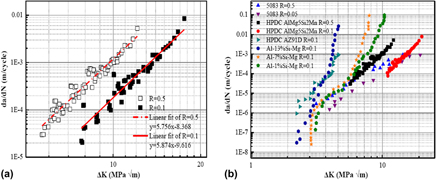Published online by Cambridge University Press: 05 March 2015

High performance die castings are urgently expected to be used as structural components subjected to dynamic loading. Therefore, tensile properties, fatigue, and corrosion-fatigue behavior of automotive die cast AlMg5Si2Mn alloy are studied in the current work. The results indicate that the tensile strength and yield strength of the as-cast specimens are obviously lower than those of the age-treated specimens, while the elongation decreases with increasing aging time. Neutral corrosive environment (3.5% NaCl solution) dramatically decreases the fatigue limits from 75 to 50 MPa. Fatigue lives of the directly corroded and precorroded specimens are close to each other. The values of material constants m and C are in the range of 5.756–5.874 and 2.421 × 10−10 to 4.285 × 10−9, respectively. Obscure fatigue striations and featureless facets are observed in crack propagation regions. Anodic dissolution is dominantly responsible for the premature crack initiation and stress corrosion cracking leading to the formation of fractured α-Al matrix.